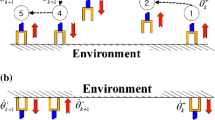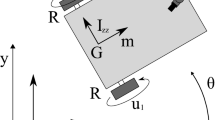Abstract
In paper ‘Robustness of Adaptive Control of Robots’ by Ghorbel and Spong, the adaptive control of flexible joint robots is investigated using a singular perturbation approach and composite Lyapunov theory. In this note, we correct a missing term from the boundary-layer system of that paper and then show that the stability analysis presented remains valid.
Similar content being viewed by others
References
Coppel, W.A.,Dichotomies in Stability Theory, Lecture Notes in Mathematics 629, Springer, New York, 1978.
Ghorbel, F. and Spong, M.W., Robustness of adaptive control of robots,J. Intell. Robotic Systems 6 (1992), 3–15.
Ghorbel, F., Adaptive control of flexible joint robot manipulators: A singular perturbation approach, PhD thesis, Department of Mechanical Engineering, University of Illinois at Urbana-Champaign, December, 1990.
Khalil, H.K.,Nonlinear Systems, Macmillan, New York, 1992.
Kokotović, P.V., Khalil, H.K., and O'Reilly, J.,Singular Perturbation Methods in Control:Analysis and Design, Academic Press, London, 1986.
Saberi, A. and Khalil, H.K., Quadratic-type Lyapunov functions for singularly perturbed systems,IEEE Trans. Automat. Control AC-29(6), June 1984.
Author information
Authors and Affiliations
Rights and permissions
About this article
Cite this article
Ghorbel, F., Spong, M.W. Correction to ‘Robustness of Adaptive Control of Robots’ by F. Ghorbel and M.W. Spong. J Intell Robot Syst 10, 209–215 (1994). https://doi.org/10.1007/BF01258229
Received:
Issue Date:
DOI: https://doi.org/10.1007/BF01258229




